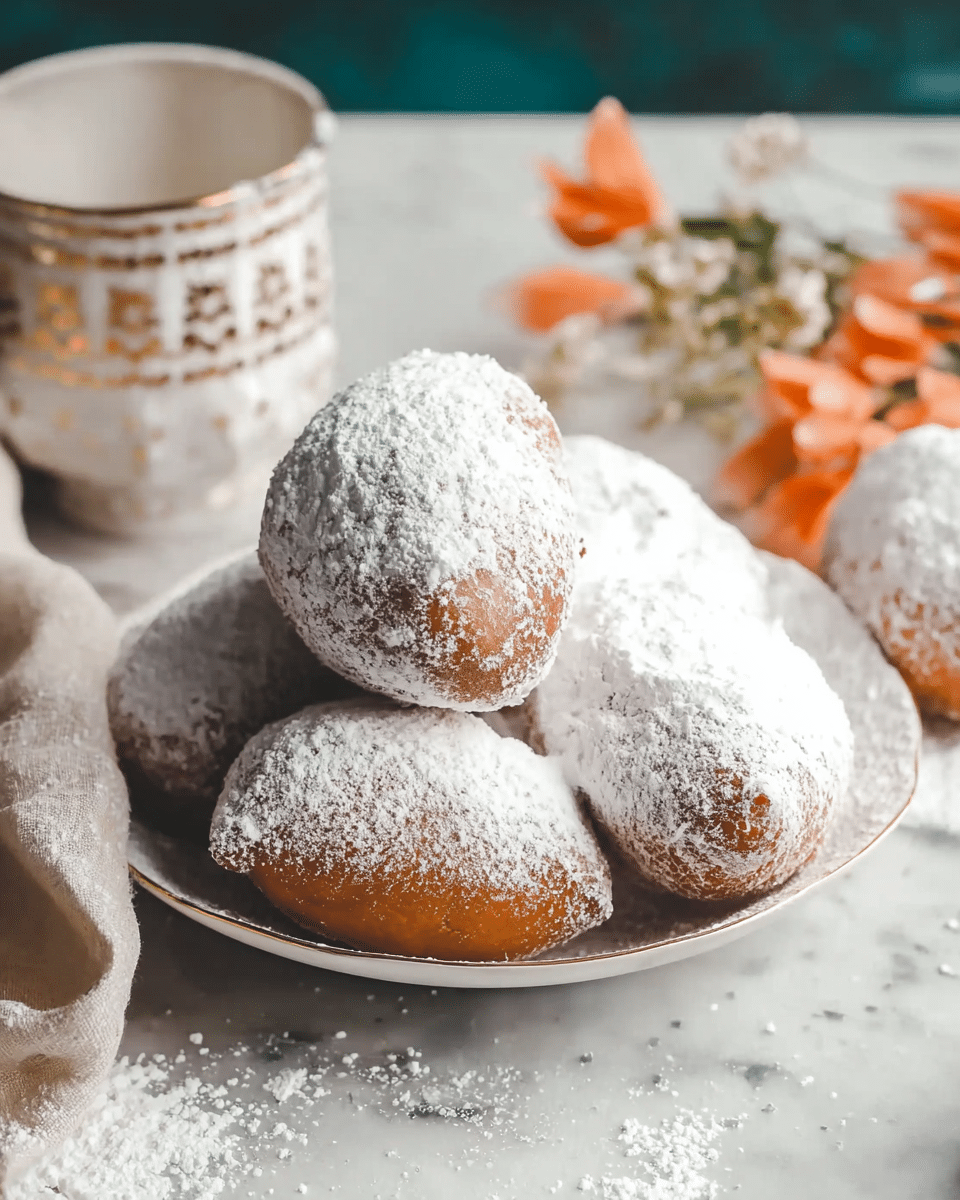Imagine biting into a beignet so light and tender it practically melts on your tongue these Southern Morning Cloud Beignets bring that experience straight into your home kitchen. With their golden-brown exterior and snow-like sugar coating, they capture the soul of New Orleans-style indulgence, elevated by the gentle tang and richness of buttermilk and egg yolk in every bite.
Perfect for a cozy brunch, weekend treat, or a show-stopping dessert, these beignets are surprisingly simple to make and profoundly satisfying. From the moment the dough rises until that first sugar-coated puff lands in your mouth, you’ll discover why this timeless Southern classic continues to delight and comfort.
Full Recipe:
-
Ingredients:
-
1 cup warm water (105–110 °F)
-
1 tbsp granulated sugar (for yeast activation)
-
2 tsp active dry yeast
-
⅓ cup granulated sugar (remaining)
-
⅔ cup buttermilk
-
1 large egg
-
1 large egg yolk
-
3 tbsp unsalted butter, melted
-
4⅓ cups all-purpose flour, plus extra for dusting
-
1 tsp sea salt
-
1.5 L grapeseed oil or other neutral frying oil
-
1 cup powdered sugar (for coating)
Directions:
-
In a large bowl, whisk warm water, 1 tbsp sugar, and yeast. Let sit 7–10 minutes until foamy.
-
Add remaining sugar, buttermilk, egg, egg yolk, and melted butter; whisk until smooth.
-
Stir in flour and salt until dough forms and begins to pull away from the bowl. If kneading by hand, knead for 5 minutes until smooth (stand mixer optional).
-
Cover the bowl lightly and let dough rise in a greased bowl for 90 minutes, until doubled.
-
On a floured surface, roll dough to ½-inch thickness. Cut into 2″ × 3″ rectangles.
-
Heat oil in a deep pan to 350 °F (2–3 inches deep). Fry 5–6 beignets at a time for ~2 minutes per side until puffed and golden.
-
Drain on paper towels. Place warm beignets in a bag with powdered sugar and shake to coat. Serve immediately.
Prep Time: 20 minutes | Cooking Time: 20 minutes | Total Time: 40 minutes | Kcal: ~210 kcal per beignet | Servings: ~20 beignets
Introduction: The Southern Tradition of Beignets
Buttermilk beignets are a beloved Southern treat that have become synonymous with the lively streets of New Orleans. These fluffy, deep-fried pastries, generously dusted with powdered sugar, have a rich history and have evolved into a comforting and indulgent snack enjoyed by many worldwide. Whether you’re experiencing Mardi Gras festivities or savoring a quiet morning at home, beignets have a unique way of bringing joy. The combination of buttermilk’s tangy richness with the soft, pillowy texture and the crisp, golden exterior creates a sensory experience unlike any other.
Origins of Beignets: From France to New Orleans
Beignets, the iconic French pastry, made their way to the United States through French colonization. The word “beignet” means “fritter” in French, and the French have enjoyed versions of fried dough for centuries. While the beignet itself may have its roots in France, it was in New Orleans where the treat evolved into the deep-fried, square-shaped delicacy we recognize today.
The French settlers brought their tradition of sweet and savory doughnuts to the Bayou, and over time, this pastry became a defining feature of Creole and Cajun culture. The New Orleans version of beignets is most famously served at Café du Monde, where visitors from all over the world flock to indulge in these warm, sugar-dusted treasures, often accompanied by a steaming cup of café au lait.
Why Buttermilk Makes a Difference in Beignets
What sets these beignets apart is the use of buttermilk in the dough. While traditional beignets are made with regular milk or water, the tangy richness of buttermilk helps to tenderize the dough, giving it a soft and light texture. Buttermilk reacts with the baking soda, allowing the dough to rise and become airy while maintaining a slight chewiness that is crucial to the beignet’s signature bite.
The acidity in buttermilk also balances out the sweetness of the powdered sugar, enhancing the overall flavor of the pastry. This slight tangy note contrasts beautifully with the deep-fried exterior, creating a flavor profile that is both satisfying and addictive. Whether you’re making them for a special occasion or simply to indulge in a comforting snack, buttermilk provides the essential ingredient that elevates the texture and taste of the beignets.
The Art of Frying Beignets
One of the most important aspects of making homemade beignets is mastering the frying process. The right temperature of oil is key to achieving the perfect golden-brown crust. If the oil is too hot, the beignets will burn on the outside before they are fully cooked on the inside. If the oil is too cool, the beignets will absorb excess oil, becoming greasy and heavy rather than light and crispy.
To test the oil temperature, it’s recommended to use a thermometer and heat the oil to around 350°F (175°C). This ensures that the beignets fry evenly and maintain that perfect crispy exterior. Frying in small batches is also crucial to prevent overcrowding, which can lower the temperature of the oil and result in uneven cooking.
The key to perfect beignets is achieving that contrast between a crisp, slightly crunchy shell and a soft, airy interior. Once the dough puffs up and turns a rich golden brown, it should be removed from the oil and placed on a paper towel to drain any excess oil. The final touch is rolling the beignets in powdered sugar while they are still warm, allowing the sugar to adhere to the exterior.
Why Homemade Beignets Are Worth the Effort
Making homemade beignets may seem like a bit of an undertaking, but the reward is undoubtedly worth the effort. There is something incredibly satisfying about creating these pastries from scratch. The process allows you to engage with each step of the recipe, from activating the yeast to frying and finally dusting the beignets with sugar. The result is an authentic, indulgent treat that can’t be replicated by store-bought versions.
Not only do homemade beignets offer superior freshness, but you can also customize the flavors and textures to suit your personal preferences. For instance, you can adjust the amount of sugar to make them sweeter or less sweet, depending on your taste. The softness and pillowy texture of the dough, paired with the right balance of crispness from the frying process, create an irresistible pastry that stands out as a highlight in any meal or gathering.
Beignets as Part of a Larger Meal: Perfect for Any Occasion
Buttermilk beignets are versatile and can be enjoyed in many different contexts. While they are most commonly served as a sweet breakfast or brunch dish, they can also be the perfect dessert to conclude a meal. Paired with a hot cup of coffee or a frothy latte, beignets make for an excellent afternoon snack.
During festive occasions like Mardi Gras or holiday gatherings, serving beignets adds an element of joy and celebration to the table. Their soft, melt-in-your-mouth texture makes them a great treat for guests, and their sweet aroma as they fry in the kitchen will surely bring smiles all around.
In addition, beignets are easily customizable. While the traditional version calls for powdered sugar, you can add your own twist with cinnamon sugar, chocolate sauce, or even fruit fillings. Some people enjoy adding a dollop of whipped cream or pairing them with fresh berries for a delicious contrast of flavors.
The Health Perspective: A Treat in Moderation
Though buttermilk beignets are undeniably indulgent, they can still be enjoyed as part of a balanced lifestyle when consumed in moderation. The ingredients are simple flour, buttermilk, eggs, sugar, and butter—which are readily available in most kitchens. While beignets are high in calories and fat due to the deep frying process, the indulgence is typically reserved for special occasions. It’s important to remember that beignets are best savored as a treat rather than an everyday snack.
To make them a bit lighter, you could experiment with baking them instead of frying. While they may not have the same crispy exterior as fried beignets, the result will still be a delightful, less greasy version of this Southern classic. However, nothing quite compares to the authentic fried beignet, with its crispy edges and pillowy center.
Conclusion: The Joy of Homemade Beignets
In the end, homemade buttermilk beignets embody the joy of baking a process that turns simple ingredients into a delightful treat. The crispy, golden exterior and soft, airy interior combine to create a perfect pastry that brings a taste of New Orleans to your home kitchen. Whether you’re celebrating a special occasion or simply satisfying your sweet tooth, these beignets are sure to make a lasting impression. So roll up your sleeves, get your oil heated, and enjoy the process of creating a timeless classic that’s as rewarding to make as it is to eat.
As you enjoy each bite of these delicious pastries, you’ll experience a blend of nostalgia and indulgence that only homemade beignets can offer. From the rise of the dough to the sweet final coating of powdered sugar, every step of the recipe is an invitation to savor the magic of Southern comfort food.






